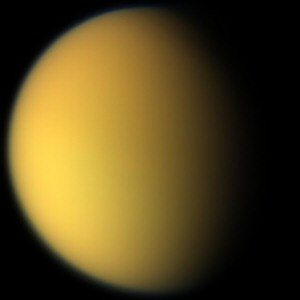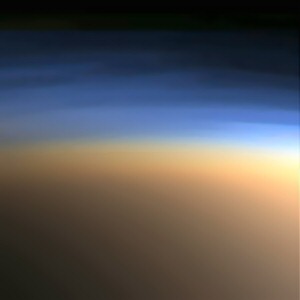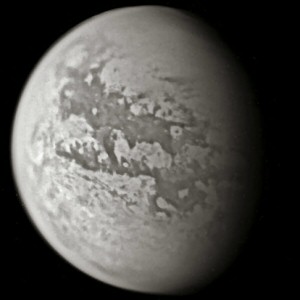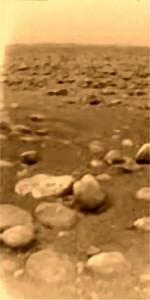Saturn's satellites
[ Titan ]
Saturn is the second largest planet in the Solar System, and, of course, is known mainly for its wonderful set of rings. The table below provides some information on the dimensions and orbital characteristics of Saturn's satellites (Illingworth, 1994). A more in-depth look at Titan can be seen below.
| Satellite | Year of Discovery |
Diameter (Km) |
Orbital Radius (Km) |
Eccentricity | Orbital Period (days) |
Inclination (°) |
|---|---|---|---|---|---|---|
| Pan | 1991 | 20 | 134 000 | ? | 0.58 | ? |
| Atlas | 1980 | 37 x 34 x 27 | 138 000 | 0.002 | 0.60 | 0.30 |
| Prometheus | 1980 | 148 x 100 x 68 | 139 000 | 0.003 | 0.61 | 0.00 |
| Pandora | 1980 | 110 x 88 x 62 | 142 000 | 0.004 | 0.63 | 0.10 |
| Epimetheus | 1978 | 194 x 190 x 154 | 151 000 | 0.009 | 0.69 | 0.34 |
| Janus | 1978 | 276 x 220 x 160 | 151 000 | 0.007 | 0.69 | 0.14 |
| Mimas | 1789 | 421 x 395 x 385 | 186 000 | 0.020 | 0.94 | 1.50 |
| Enceladus | 1789 | 512 x 495 x 488 | 238 000 | 0.005 | 1.37 | 0.02 |
| Tethys | 1684 | 1 050 | 295 000 | 0.000 | 1.89 | 1.86 |
| Telesto | 1980 | 34 x 28 x 26 | 295 000 | 0.000 | 1.89 | 2.00 |
| Calypso | 1980 | 34 x 22 x 22 | 295 000 | 0.000 | 1.89 | 2.00 |
| Dione | 1684 | 1 120 | 377 000 | 0.002 | 2.74 | 0.02 |
| Helene | 1980 | 36 x 32 x 30 | 377 000 | 0.005 | 2.74 | 0.20 |
| Rhea | 1672 | 1 530 | 527 000 | 0.001 | 4.52 | 0.35 |
| Titan | 1655 | 5 150 | 1 222 000 | 0.029 | 15.95 | 0.33 |
| Hyperion | 1848 | 405 x 260 x 220 | 1 481 000 | 0.104 | 21.28 | 0.43 |
| Iapetus | 1671 | 1 440 | 3 561 000 | 0.028 | 79.33 | 14.72 |
| Phoebe | 1898 | 230 x 220 x 210 | 12 952 000 | 0.163 | 550.48 R | 175.30 |
Titan
Titan is the only satellite in the Solar System to possess a substantial atmosphere. Surface pressure reaches around 1,500 millibars, compared to an average of 1,000 millibars on Earth. This is despite the fact that Titan itself is only 5,150 km in diameter compared to Earth's 12,756 km.

[ NASA / JPL / Caltech ]
Titan's day is 16 Earth days in length, and it also takes 16 days to complete one orbit of Saturn. This means that the same hemisphere of Titan always faces Saturn, much as the same hemisphere of the Moon always faces Earth.


[ NASA / JPL / Caltech ]
When Voyager 1 conducted its flyby of Saturn in November 1980, it imaged a satellite enshrouded in a nitrogen atmosphere with thick methane clouds that completely obscured the surface from view. However, a clear division was apparent between slightly darker orange clouds in the northern hemisphere, and lighter orange clouds in the southern hemisphere - a detail that is still discernable in higher-resolution images from Cassini (as in the left image, above). Cassini has also imaged persistent layers of high-altitude haze in Titan's atmosphere (as in the right image, above). It has been determined that in these layers methane is broken down by ultra-violet (UV) radiation, and the chemical byproducts of this reaction go on to form ethane and acetylene.


[ NASA / JPL / Caltech ]
In the above-left image, from Cassini, the light areas are highland regions and the dark areas are lowlands. It was postulated before Huygens landed that Titan might possess oceans of liquid methane and ethane. While this remains possible, it seems that the darker areas are actually 'sludgy' in texture. This follows data from the Huygens surface-impact instrument, which recorded a surface texture very similar to treacle! The image on the right, above, is Huygens' best view (slightly contrast-enhanced) of the surface itself. The pebbles are most likely to consist of rock-hard water ice, and the darker matrix around them is the sludgy surface material.
The University of Arizona has put together some maps of Titan's surface, including some global views and a mercator projection, along with other images.